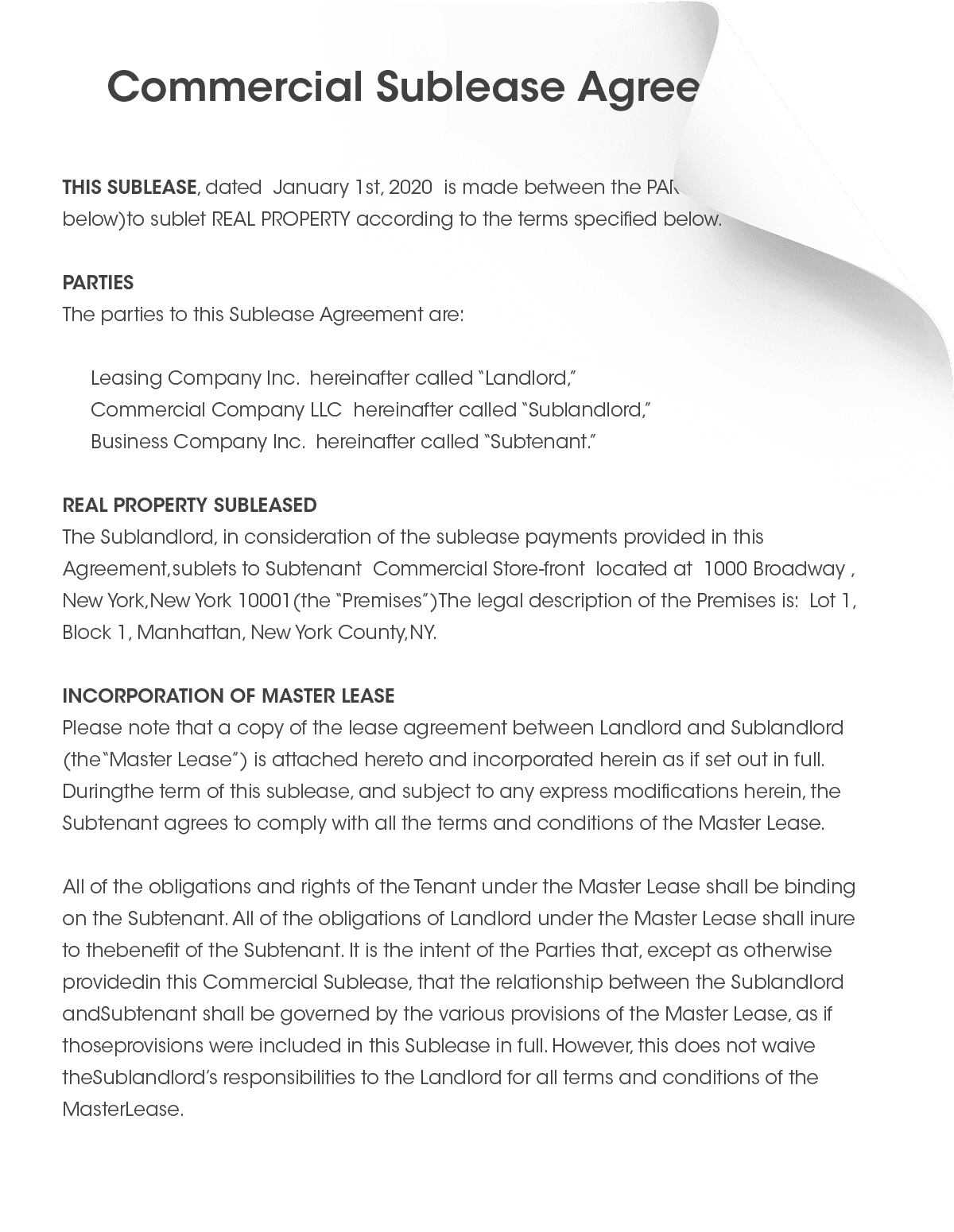What is a Commercial Sublease Agreement?
A Commercial Sublease Agreement is a legally binding contract between a tenant (the original leaseholder) and a subtenant (also known as a sublessee). This agreement allows the subtenant to lease part or all of the commercial property from the tenant, rather than directly from the landlord.
Under this arrangement, the subtenant pays rent to the tenant, who remains responsible for the lease’s obligations, including rent payments and property maintenance. Importantly, landlords typically require tenants to obtain formal permission before subleasing a sublease commercial space.
Why Would You Need a Commercial Sublease Agreement?
A Commercial Sublease Agreement is essential when the original tenant wishes to rent out part or all of their leased sublease commercial space to another party, known as the subtenant. This typically occurs when a tenant has extra space they don’t need, wants to share costs, or can no longer fulfill the lease obligations but wants to avoid breaking the lease altogether.
Before subleasing, the tenant must formally outline all terms and conditions in a written contract. This ensures both parties agree on key details such as rent amount, duration, permitted uses of the space, and maintenance responsibilities. A well-drafted commercial sublease agreement template helps prevent misunderstandings and protects the rights of both the tenant and the subtenant.
However, a sublease must not violate the terms of the original lease agreement. Many commercial leases require the landlord’s written consent before a sublease can take effect. If the tenant subleases without permission or breaches lease terms, the landlord may take legal action, which could include eviction or financial penalties. Therefore, it’s crucial to review the original lease and obtain necessary approvals before proceeding with a commercial sublease.
When Do You Need to Use a Commercial Sublease Agreement?

A Commercial Sublease Agreement is necessary when a tenant (the original leaseholder) wants to rent out all or part of their leased commercial space to a third party while still being responsible for the original lease terms. Common situations where a commercial sublease form is used include:
- Downsizing or Unused Space – If a business has extra space it no longer needs, subleasing can help offset rental costs.
- Temporary Relocation – If a business relocates temporarily but wants to retain the lease for future use, subleasing allows another party to use the space in the meantime.
- Financial Relief – If a tenant is struggling to meet rental obligations, subleasing can provide financial support by allowing a subtenant to share or cover the rent.
- Lease Commitment Issues – If a tenant wants to leave a leased property before the lease term ends but cannot break the lease without penalties, subleasing can be a viable alternative.
- Shared Office or Retail Space – Businesses that don’t require an entire commercial space may sublease part of the property to another business to optimize costs.
Before subleasing, it’s important to review the original lease agreement and obtain landlord approval, as unauthorized subleasing could result in legal consequences or lease termination.
What are the Main Things That Go on This Form?
A Commercial Sublease Agreement should include the following key details to ensure clarity and legal protection for all parties involved:
1) Parties Involved –
Names and contact information of the original tenant (sublessor) and the subtenant (sublessee).
2) Property Details –
Address and description of the commercial space being subleased, including any specific areas or shared facilities.
3) Term of the Sublease –
Start and end date of the sublease, along with any renewal options or conditions for early termination.
4) Rent and Payment Terms –
Monthly rent amount, due date, acceptable payment methods, and any penalties for late payments.
5) Security Deposit –
Amount required, conditions for its return, and circumstances under which deductions may be made.
6) Use of the Property –
Permitted business activities and any restrictions outlined in the original lease.
7) Maintenance and Repairs –
Responsibilities of the subtenant versus the original tenant for property upkeep and repairs.
8) Utilities and Expenses –
Who will cover costs such as electricity, water, internet, and property maintenance fees.
9) Landlord Approval –
Confirmation that the landlord has provided written consent for the sublease.
10) Liability and Insurance –
Details on liability coverage, insurance requirements, and who is responsible for damages or legal issues.
11) Compliance with Original Lease –
A statement that the sublease agreement must adhere to the terms of the original lease, with no violations permitted.
12) Termination Clause –
Conditions under which the sublease can be terminated early by either party.
13) Signatures –
Legal signatures of both the sublessor and sublessee, with the date of agreement execution.
What are the Most Common Mistakes to Avoid With This Form?

Avoiding these common mistakes can help ensure a smooth and legally sound subleasing process:
– Failing to Review the Original Lease Agreement –
Before entering a sublease, both the original tenant and the subtenant must carefully review the primary lease agreement. Many leases have restrictions on subleasing or require landlord approval. Violating these terms can lead to legal consequences or lease termination.
– Unclear Premises Usage –
Be specific about what parts of the property the subtenant can use. For example, if access to a conference room is allowed, specify the permitted hours. Clearly outlining the space and its usage prevents misunderstandings.
– Unspecified Maintenance Responsibilities –
Clearly define who is responsible for maintenance and repairs. Additionally, state whether the subtenant can make modifications to the space. Ambiguity in this area can lead to disputes over repairs or unauthorized alterations.
– Vague or Ambiguous Language –
Avoid using overly broad or unclear terms in the agreement. Precise language ensures that both parties understand their obligations, reducing the risk of legal disputes in the future.
Do I need to use a lawyer, accountant, or notary to help me?
It’s not legally required, but consulting a lawyer ensures the sublease complies with the original lease and local laws. An accountant can help with tax implications, and a notary may be needed if notarization is required by state law or the landlord.
You can easily create a free sublease agreement without hiring a lawyer, accountant, or notary. Creating the form online saves you time and eliminates extra costs.
Why Use Our Commercial Sublease Agreement Generator?
Our user-friendly tool allows you to create a legally sound commercial sublease agreement template in under two minutes. It’s 100% secure and encrypted, ensuring your data stays protected. The form is automatically filled with accurate calculations, reducing errors and saving time. Plus, with our affordable subscription plan, you can generate unlimited sublease agreements at a fraction of the cost of hiring a lawyer.
Create a Commercial Sublease Agreement Now
FormPros Has You Covered
Simplify your paperwork with FormPros! From creating paystubs, W-2s, and 1099-NEC forms to generating LLC Operating Agreements and even voided checks, our easy-to-use platform has you covered. Save time, reduce errors, and handle your business documents with confidence. Start now and see how FormPros makes professional form generation fast, affordable, and hassle-free!
Commercial Sublease Agreement FAQs
-
Can a subtenant further sublease the property to another party?
In most cases, a subtenant cannot sublease the property to another party unless explicitly allowed in the sublease agreement and approved by the original landlord. This process, known as sub-subleasing, can create legal complexities, as the original tenant remains responsible for the lease. If a subtenant wants to sublease to someone else, they must obtain written consent from both the original tenant and the landlord.
-
What happens if the original tenant stops paying rent to the landlord?
If the original tenant fails to pay rent to the landlord, the landlord may take legal action against the tenant, which can lead to eviction—even if the subtenant is making timely payments to the tenant. To mitigate this risk, subtenants may request a non-disturbance agreement, which allows them to continue occupying the space even if the primary lease is terminated due to the original tenant’s default.
-
Can a subtenant negotiate a rent reduction or lease modifications?
Yes, a subtenant can negotiate terms such as rent adjustments, lease duration, and permitted uses before signing the sublease agreement. However, any changes must still comply with the original lease and typically require landlord approval. Subtenants should carefully review both the sublease and primary lease to understand their rights and limitations.
-
What should a subtenant do if they need to exit the sublease early?
If a subtenant needs to terminate their sublease early, they should first review the termination clause in the sublease agreement. Some agreements allow for early termination with prior notice or a penalty fee. If no clause exists, the subtenant may try negotiating an exit agreement with the original tenant. Failing to fulfill the agreed-upon lease terms could result in legal or financial consequences.
-
How can a subtenant ensure they are protected in case of disputes?
To protect themselves, subtenants should:
- Request a written and signed agreement covering all lease terms.
- Ensure they have landlord approval for the sublease.
- Maintain records of all rent payments and communication with the tenant and landlord.
- Consider legal review of the sublease to confirm compliance with the original lease terms.
- Secure a non-disturbance clause (if possible) to prevent eviction if the primary tenant defaults.





